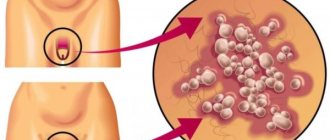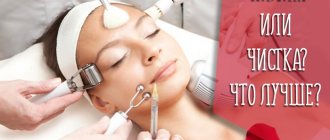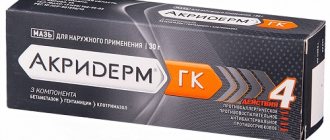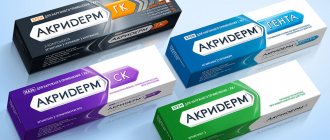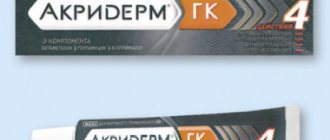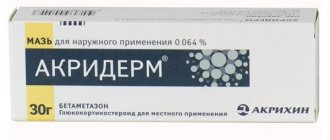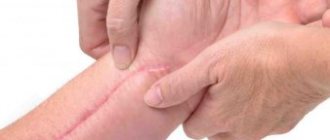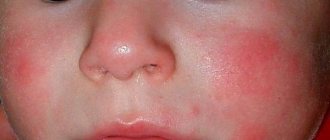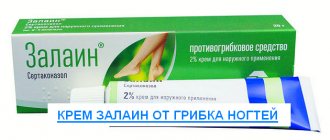Akriderm GK is a steroidal anti-inflammatory drug. Belongs to glucocorticoids - a group of drugs that have anti-stress, anti-shock effects, strengthen general immunity, stimulate metabolism, kill viruses and fungi. Akriderm GK is prescribed for the treatment of skin diseases. But patients are interested in the question: what to choose, Akriderm GK ointment or cream.
Properties of the drug
This is a combined topical drug. It consists of three substances:
- betamethasone (0.064 g);
- gentamicin – (0.1 g);
- clotrimazole – (1 g).
Indications for antibiotic use:
- lichen;
- mycoses;
- thrush;
- diffuse neurodermatitis;
- atopic and other dermatitis;
- eczema;
- psoriasis.
In ointment form
A translucent whitish mass with a dense, greasy texture. Available in tubes of 15 and 30 g. Shelf life - 2 years. Store away from children and sunlight, at a temperature of 15–25 °C. Produced in Russia. No prescription required upon purchase.
In the form of a cream
Less dense, non-greasy mass of white color. Available in tubes of 15 and 30 g. Shelf life - 2 years. Store away from children and sunlight, at a temperature of 15–25 °C. Produced in Russia. No prescription required upon purchase.
What is the difference between the types of drugs?
Unlike other drugs for the treatment of skin dermatoses or acne, Akriderm acts in a complex manner due to the hormone it contains. The ointment quickly suppresses the symptoms of eczema, psoriasis, urticaria, and promotes long-term remission.
Distinctive features are also the features of using Akriderm. To treat facial skin, ointment can be used only in the most extreme cases and for a short time.
This potent drug is not recommended for use in the treatment of skin diseases in children and pregnant women.
SK and GC (difference and composition)
There are several types of ointment, such as Akriderm SK and Akriderm GK. They differ slightly in composition. The first product contains salicylic acid, and the second contains the antibiotic gentamicin and the antimycotic clotrimazole.
Akriderm GK also has antimicrobial and antifungal effects. It is used in cases where the skin disease is complicated by the addition of bacterial flora, for example, pustular formations, boils, and pyoderma have arisen.
Akriderm SK ointment promotes exfoliation of the upper stratum corneum of the epidermis, helps with thickening and roughening of the skin.
What is better to choose for acne on the face?
If you are worried about acne on your face, it is best to consult a dermatologist. After a thorough examination and additional tests, the doctor will be able to determine the exact cause of the disease and select the necessary treatment and care products.
Most often, Akriderm cream or ointment is used to treat uncomplicated forms of acne.
If, in addition to acne, an inflammatory rash or ulcers appear on the face, it is better to use Akriderm GK ointment.
What remedy helps with psoriasis?
The selection of external medications for psoriasis should be carried out by a dermatovenerologist. Self-medication can be harmful to health and lead to deterioration of skin condition.
For dry, flaky skin due to psoriasis, it is best to use Akriderm or Akriderm SK ointment.
Akriderm Genta and GK ointments are prescribed by a doctor only for inflammatory complications and should not be used continuously so as not to cause addiction.
What is the difference between cream and ointment Akriderm GK
Medicines differ in the composition of auxiliary components.
Compound
Composition of Akriderm GK cream:
- petrolatum;
- E1520;
- liquid paraffin;
- cetearyl alcohol;
- Cremophor A25;
- disodium salt of ethylenediaminetetraacetic acid;
- sodium dihydrogen phosphate dihydrate;
- water.
Composition of Akriderm GK ointment:
- E216;
- Vaseline oil;
- isopropyl myristate;
- petrolatum.
How they work
Akriderm GK is a broad-spectrum antimicrobial agent. Has the following effect:
- relieves inflammation;
- kills bacteria, microbes;
- reduces allergy symptoms;
- kills fungi.
Action of active components:
- betamethazole relieves inflammation, swelling, and other manifestations of allergies;
- gentamicin kills bacteria, viruses (broad spectrum antibiotic);
- Clotrimazole kills fungi (broad spectrum agent).
A small amount of medicine is applied to the inflamed area and rubbed in with gentle movements. It is recommended to use the drug twice a day, the general course of treatment is selected individually (depending on the severity of the disease and the general condition of the patient). The duration of treatment varies from 5 days to 4 weeks (depending on the specifics and severity of the disease).
Contraindications and side effects
When it is prohibited to use the drug:
- allergy to the composition;
- tuberculous skin lesions;
- dermatological manifestations of syphilis;
- herpes;
- chickenpox;
- fresh open wounds;
- children under 2 years of age;
- lactation period.
The use of the drug during pregnancy is permitted only if the intended benefit to the mother outweighs the risk to the fetus. Therapy should be carried out under the supervision of a physician. The course of treatment should be short. Small application areas.
It is recommended to use the drug with caution in pediatrics. When treating children from 2 to 18 years of age, special supervision is required.
Adverse reactions include:
- skin itching;
- drying, peeling of the skin;
- tingling;
- burning sensation;
- folliculitis;
- increased hairiness;
- acne;
- vitilingo;
- allergy.
The stronger the skin damage, the faster and deeper the active substance penetrates. Applying a bandage further enhances the process, which becomes a prerequisite for the development of additional side effects:
- softening, tissue atrophy;
- secondary infection;
- striae;
- prickly heat.
A long course of administration also expands the list of adverse reactions. Among them are:
- weight gain;
- osteoporosis;
- hypertension;
- swelling;
- gastrointestinal diseases;
- sleep problems;
- dysmenorrhea;
- increased irritability;
- exacerbation of latent infections;
- increased blood sugar levels.
If side effects or overdose (hyperglycemia) occur, you must stop treatment and consult a doctor.
Which is cheaper?
The price does not depend on the form of release; the cost of the medicine varies depending on the dosage of the drug, the region of sale and the pharmacy.
Average price for medicines:
cream (15 g) – 420 rubles;
- ointment (15 g) – 420 rubles;
- cream (30 g) – 680 rubles;
- ointment (30 g) – 680 rubles.
Contraindications
Before starting to use hormonal ointments, you should definitely consult your doctor and also study the list of contraindications.
You cannot use Akriderm if:
- Viral skin diseases (herpes, HPV, chickenpox, molluscum contagiosum).
- Damage to the skin (in the presence of open wounds, ulcers, erosions, abrasions and scratches).
- Skin tuberculosis, syphilis.
- Allergic skin reactions that occur in response to vaccines.
- Rosacea, perioral dermatitis, acne vulgaris.
- Individual intolerance to the main or auxiliary components of the product.
Akriderm is not allowed for the treatment of children under 1 year of age and pregnant women. This ointment is used during breastfeeding only in exceptional cases and always under the supervision of a doctor.
More than 90% of patients using Akriderm noted a significant improvement in the condition of their skin and well-being. When used correctly, the itching and burning sensation decreases, the rash becomes less pronounced, and redness and swelling decrease.
Which is better: ointment or cream Akriderm GK
When choosing the form of a medicine, the stage, type and severity of the disease, the patient’s age, medical history, general health, and individual reactions are taken into account.
It is worth considering the specifics of the effects of the funds:
- the ointment creates a greasy film, which ensures the penetration of active ingredients into the deep layers of the skin;
- The cream has a lighter texture and does not penetrate into the deeper layers of the skin.
The ointment has a long-term effect on the affected skin and can have a systemic effect. The cream has an exclusively local effect, but moisturizes and cools the skin well.
Criteria for choosing a type of drug:
- If you need to act only on the upper layers of the skin, then it is recommended to choose a cream.
- If you need to use the deeper layers of the skin, it is recommended to choose an ointment.
- The cream is suitable for moisturizing and cooling the skin, relieving symptoms of acute inflammation.
- The ointment is suitable for the treatment of chronic diseases.
- If there is a secondary infection, it is recommended to use ointment.
Reviews from doctors about Akriderm GK ointment and cream
Yulia Nikolaevna, cosmetologist: “I often use this drug. Due to its wide range of actions, the medicine becomes an indispensable tool in cosmetology and dermatology. In complex therapy, it quickly and without side effects treats eczema and dermatitis.”
Nadezhda Viktorovna, dermatologist: “A universal and very good product. An excellent combination drug. The effect is noticeable immediately, and lasting results are observed within a few days. It relieves swelling well and helps fight secondary infections and dermatitis. Adverse reactions occur rarely. When choosing a release form, I am guided by the patients’ individual medical histories.”
Andrey Yurievich, dermatologist: “I prescribe both forms of the drug. If you choose the right form and course of administration, then no side effects are observed. Both medications are suitable for treating simple allergies as well as complex skin diseases. I do not recommend long-term use of the cream when treating defects on the facial skin.”
Instructions for use
Daily and single dosages of the drug can vary significantly, as well as the duration of the therapeutic course. The use of glucocorticosteroids is carried out under medical supervision, especially in the treatment of young children. If a full-fledged non-hormonal analogue is available, Akriderm is replaced with a safer product.
It is strictly forbidden to increase the frequency and amount of products applied during treatment. This will not only not speed up recovery, but will also slow down the regeneration of tissues affected by inflammation.
Indications and contraindications
The drug is prescribed to patients diagnosed with dermatitis, including psoriasis, which causes itching and pain. The drug effectively copes with pathologies of neurogenic origin that arise against the background of stressful situations. The main indications for the use of Akriderm ointment and cream are:
- allergic dermatitis;
- simple dermatitis;
- psoriasis;
- dry and weeping eczema;
- neurodermatitis.
The product is not intended for treatment during breastfeeding due to its ability to overcome biological barriers. The drug is not prescribed to children under one year of age and to patients who are sensitive to its ingredients. Akriderm is not used in the treatment of acne, herpetic eruptions, or venereal pathologies.
Side effects and special instructions
The presence of a hormonal compound in the drug requires compliance with all medical recommendations during treatment. A slight excess of dosage will provoke the development of a sensitization reaction. It is characterized by the appearance of small blisters, redness and severe swelling on the skin.
With prolonged use of ointments and creams, inflammation of the hair follicles, decreased pigmentation, and dissolution of the intercellular substance are possible.
Sometimes systemic side effects occur:
- headaches, sleep disturbances, increased fatigue;
- indigestion and peristalsis.
Akriderm is not advisable to use for the treatment of facial skin pathologies. If such a need exists, then contact of the external agent with the eyes should be avoided. Like all hormonal drugs, Akriderm is subject to gradual withdrawal to prevent exacerbation of the disease.
Directions for use and doses
Preparations from the Akriderm therapeutic line (GK, SK, Genta) should be applied in a thin layer twice a day. It is not recommended to rub cream or ointment into damaged skin. The product is used morning and evening for a week. Patients with chronic pathologies of the liver and kidneys, as well as young children, are prescribed a single use of the drug.
If after two days there is no improvement or it is insignificant, then you need to inform your dermatologist about this. He will adjust the dosage or replace it with a more effective drug.
Patient reviews
Vladimir: “I have been suffering from allergies to household chemicals for ten years. For minor inflammation, I use Akriderm GK cream, and for severe exacerbation, I use ointment. The product was prescribed by a dermatologist, and he also gave recommendations for use.”
Alena: “I treated psoriasis with ointment. After the first use, the pain quickly disappeared, swelling decreased, and redness decreased. The first effect was noticeable after a few hours.”
Olga: “I treated atopic dermatitis with cream. Already on the second day I noticed a clear improvement: itching decreased, swelling and redness subsided, pain went away. The doctor prescribed a course of treatment: a month, then a break, again a monthly treatment. I applied the product twice a day. Akriderm GK was an element of complex treatment, but I don’t think it was a secondary drug, rather the main remedy.”
